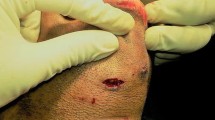Abstract
Background and Objectives
Facial abrasions, the most common squeal of trauma, have been treated widely by moist occlusive dressings. This novel study aims to evaluate polyethylene surgical drape dressing (PESG) as an alternative to autoclaved banana leaf (Musa paradisiaca) dressing in facial abrasions.
Study Design
Sixty patients who reported to our emergency department, having abrasions over head, neck and face region secondary to trauma, were included. Thirty patients were given PESG, and 30 were given banana leaf dressings. Dressings were changed daily for 7 days. Pain on dressing change, status of wound bed on every dressing change, handling characteristics of each dressing material and comfort to the patient were assessed.
Results
Analysis revealed that the properties of PESG dressings are parallel to banana leaf dressing in all aspects except pain on dressing change. PESG caused no pain during dressing change which was statistically significant (p < 0.011).
Conclusion
Facial abrasions can be effectively treated by PESG dressing. It is easily available in any hospital setting, has an ideal surface, i.e. impervious and smooth. It also maintains a moist condition, is completely painless and inexpensive. Hence, it can become a new standard for treating facial abrasions especially to poor patients in developing countries.









Similar content being viewed by others
References
Hoetzenecker W, Guenova E, Moehrle M et al (2013) Banana leaves: an alternative wound dressing material? Expert Rev Dermatol 8(5):439–440
Canadian Agency of Drugs and Technologies in Health (CADTH) (2011 Feb) Non-adherent versus traditional dressings for wound care: comparative effectiveness, safety, and guidelines. Rapid response report
Doughty D (2005) Dressings and more: guidelines for topical wound management. Nurs Clin N Am 40:217–231
Moffatt CJ, Franks PJ, Hollinworth H (2002) Understanding wound pain and trauma: an international perspective. Position document. Europe Wound Management Association, Frederiksberg
Gore AM, Umakumar K, Iyer SP (2013) Polyethylene surgical drape dressing for split thickness skin graft donor areas. In: Gore M (ed) Skin grafts. IntechOpen, Delhi
Gore AM, Akolekar D (2003) Banana leaf dressing for skin graft donor areas. Burns 29:483–486
Vartak AM (2016) Care of the burn wound: as I do it. Indian J Burns 24:3–7
Srinivas CR et al (2006) Achieving asepsis in banana leaves for the management of toxic epidermal necrolysis. Indian J Dermatol Venereol Leprol 72:201–202
Cook KF, Dunn W (2013) Pain assessment using the NIH Toolbox. Neurology 80(Suppl 3):S49–S53
Harding K (2007) Principles of best practice: wound exudate and the role of dressings: a consensus document. World union of Wound Healing Society. MEP Ltd., London
Ong TK, Dudley M (1999) Craniofacial trauma presenting at an adult accident and emergency department with an emphasis on soft tissue injuries. Inj Int J Care Inj 30:357–363
O’Donoghue GM (1979) An analysis of the pattern of facial injuries in a general accident department. Inj Int J Care Injur 11(1):52–61
Soft Crecelius C, Trauma Tissue (2013) Atlas of oral maxillofacial surgery. Clinics 21(1):49–60
Beam JW (2008) Occlusive dressings and the healing of standardized abrasions. J Athl Train 43(6):600–607
Claus EE, Fusco CF, Ingram T et al (1998) Comparison of the effects of selected dressings on the healing of standardized abrasions. J Athl Train 33(2):145–149
Hinman CD, Maibach H (1963) Effect of air exposure and occlusion on experimental human skin wounds. Nature 200:377–385
Kim J, Park J, Park N (2012) Treatment of facial abrasion using Amnisite BA(R). J Korean Burn Soc 15(1):24–29
Gore AM, Akolekar D (2003) Evaluation of banana leaf dressing for partial thickness burn wounds. Burns 29:487–492
Eaglstein WH, Mertz PM (1978) New method for assessing epidermal wound healing: the effects of triamcinolone acetonide and polyethelene film occlusion. J Investig Dermatol 71(6):382–384
Author information
Authors and Affiliations
Corresponding author
Ethics declarations
Conflict of Interest
The author declares that they have no conflict of interest.
Animal and Human Rights
This article does not contain any studies with animals performed by any of the authors.
Ethical Approval
All procedures performed in studies involving human participants were in accordance with the ethical standards of the institutional and/or national research committee and with the 1964 Helsinki declaration and its later amendments or comparable ethical standards. The institutional ethical approval was obtained from the concerning body and its copy has been attached in the supplemental file.
Informed Consent
Informed consent was obtained from all individual participants included in the study. The sample form has been attached in the supplemental file.
Additional information
Publisher's Note
Springer Nature remains neutral with regard to jurisdictional claims in published maps and institutional affiliations.
Electronic supplementary material
Below is the link to the electronic supplementary material.
Rights and permissions
About this article
Cite this article
Mulukutla, S., Kale, T.P. Evaluation of Polyethylene Surgical Drape as an Alternative Wound Dressing Material, Compared to Banana Leaf (Musa paradisiaca) Dressing in Facial Abrasions. J. Maxillofac. Oral Surg. 19, 539–545 (2020). https://doi.org/10.1007/s12663-019-01256-3
Received:
Accepted:
Published:
Issue Date:
DOI: https://doi.org/10.1007/s12663-019-01256-3




